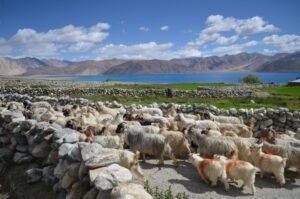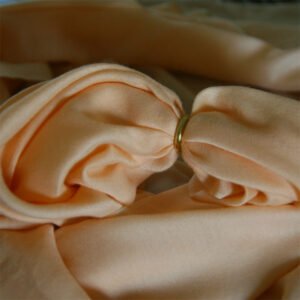Royalty is represented by Pashmina shawls, which are the pinnacle of tradition and lineage. Expert weavers in Kashmir create pashmina shawls by hand. Kashmir has been the undisputed leader in the production of Pashmina shawls for thousands of years.
The ability to weave beautiful needlework is inherited from one generation to the next. The shawls are quite hefty with prices as it takes years for an artist to become proficient in stitching, and the product belongs to those with keen eyes for detailing.
Kashmiri Pashmina is a worldwide demand for its exquisite quality. Leaders and celebrities are often seen donning the luxurious clothing. Not only to eyes, its equally compelling for the warmth of its products.
This wool has been prized for its exceptional softness, long life, warmth, and beauty for thousands of years, during which time it has been weaved into blankets and shawls.
The Kashmiri Pashmina shawl is the world’s finest craftsmanship, which turns the incredibly delicate cashmere fibers into regal accessories.
Sozni, papier-mâché, and Aari embroidery are the three primary forms used on Pashmina shawls.
Sozni is a type of needlework with flowers and paisleys done on the shawl’s sides.
The entire shawl is covered in papier-mâché, which is hook embroidery. Kaani is yet another form that is gaining its hype in Pashmina. Followed by Kalamkaari and additionally, designs are created as motif, which comprises of black-outlined foliage and flowers. Although grey, brown, and white are the fundamental colors of pashmina, it may be effectively dyed to produce almost 400 lovely rainbow colors.
The Origin Of Pashmina
The 15th-century Kashmiri king Zayn-ul-Abidin is attributed with founding the region’s wool industry. On the other hand, Pashmina shawls date back to the third century BC. The Pashmina has long played a significant role in traditional attire.
During the Mughal era, pashmina shawls became highly desirable as symbols of nobility and rank. Babur introduced the custom of awarding khilat, or “robes of honour,” on members of his court in 1526 in recognition of their loyal service, notable accomplishments, or as a sign of royal favor. A khilat could be a set of ensembles made of Pashmina wool, including shirts, coats, gowns, pants, and turbans.
After Akbar conquered Kashmir in all its glory in 1568, a khilat ceremony required the wearing of two pashmina shawls. Pashmina shawls were also worn and given as gifts by other Safavid and Qajar rulers to members of their intimate ruling circles.

In India, Nepal, and Pakistan, pashmina shawls and blankets were part of a rich woman’s dowry and served as status symbols. Due to their high cost, these shawls were heirlooms that would be passed down through the generations rather than being bought. The shawls arrived in Europe nearly immediately after being traded extensively with Indians.
Empress Joséphine, Napoleon Bonaparte’s wife, enthusiastically embraced the pashmina shawl, which helped it become a fashion icon. The shawls were a great accessory for the French since they added style to their white robes and gave the required warmth. Because of its pricey material, rich appearance, and artistic attributes, it came to be associated with a certain social class in 19th-century French society.
The Production of Pashmina
The term Pashmina, also known as “cashmere wool,” comes from the Urdu word “Pashm,” which describes the under fleece of the Himalayan mountain goat, also known as Changthangi Goat (Capra Hircus). It is the most distinctive cashmere goat in the world.
The Changpa, a nomadic group of people that live in the Ladakh region, are the ones who produce the pashmina wool.
It can only be found in Ladakh, Jammu and Kashmir, at a height of 14,000 feet above sea level, where temperatures can drop below -40 degrees, making it even more uncommon and sought-after worldwide. A single Pashm goat can produce 3 to 8 ounces of fiber annually.

When Changthangi goats naturally shed their winter coats in the spring, a time known locally as the moulting season, the process of creating pashmina begins.
This is the time that combing, as opposed to shearing, which is the most popular technique for gathering fine wool, is used to gather the goat’s undercoat.
Unprocessed Pashmina in its raw form is delivered to Kashmir, where talented weavers and combing masters usually work by hand on projects like combing, spinning, weaving, and finishing. The bulk of the facilities that produce pashmina shawls are located in the historic Srinagar area. The production of a single pashmina shawl takes 180 hours.
After it comes, expert designers, artists, and craftspeople use centuries, old techniques that have been passed down from generation to generation to carefully refine and turn it into a fabric.

The demand for pashmina shawls was higher than the supply in the 1990s. A small number of apparel firms consequently started to falsely advertise their goods as pashmina shawls.
The traditional pashmina shawl makers suffered a loss of income as a result. To stop these unlawful conduct and safeguard the livelihoods of the local craftsmen and nomads who make the pashmina shawl, the BIS (Bureau of India Standards) intervened and granted an Indian Standard certification.
Other nations tried unsuccessfully to imitate the art. The weavers of these shawls have been weaving for decades, having inherited the technique from their ancestors. Inspired by the lakes, sunrises, and sunsets, they generally draw the designs from memory using paisley, Chinar leaves, and floral borders.
Shahtoosh Production
The Persian term that means “king of wools” is the source of the word Shahtoosh. The fine wool derived from the Chiru Tibetan antelope’s undercoat is known as “shahtoosh.”

There were originally relatively few of these shawls, and the fragile hair (measuring between 9 and 11 micrometers) had to be woven by extremely talented craftspeople. These elements added value to Shahtoosh Shawls. Shahtoosh are also referred to as “ring shawls” since they are so thin that a shawl of normal size may fit through a ring.
It is nearly impossible to handle due to its extraordinary fineness, which is where the Kashmiri weavers came into action. The Shahtoosh shawl came into being when they were able to weave shawls of the highest caliber thanks to their expertise with the best hand-combed Pashmina wool.
The Chiru Tibetan antelope is the only source of the materials used to make Shahtoosh Shawls.
Shahtoosh Ban
At an elevation of more than 5,000 meters, the Chiru antelope inhabits one of the most hostile habitats on the planet. Their unique kind of down fur, which is incredibly light and insulating, enables them to endure the harsh winters on the plateau where they congregate once a year. They are migratory creatures that go from Mongolia to Tibet annually, traditionally followed by the nomads.
At the close of the 1900s, there were fewer than 70,000 Chiru goats remaining. Ninety percent of the Tibetan antelope population was once wiped out for producing Shahtoosh shawls.

The antelope is currently categorized as an endangered species because of the worrying circumstances. Shahtoosh was banned after receiving the strongest protection available when majority of the nations signed under the Convention on International Trade in Endangered Species (CITES) prohibited the trade in this species. Consequently, there has been an increase in the Chiru goat population. It is now regarded as a species that is “near threatened.” But many illegal methods are still undertaken for producing Shahtoosh due to its high priced demand in the West. They value around US $20,000.
The pashmina-wool shawl was promoted as an alternative to the Shahtoosh shawl.
For the grass that you have just eaten, oh goat,
Give us some good Pashm.
For the water that you have just drunk, oh goat,
Give us some good Pashm.
Sit down on the grass and be still, oh goat,
So that we can take out your Pashm.
(A song the Changpa recite as they comb the Pashm wool from their goats.)
The Pashmina shawl from Kashmir has evolved into a status symbol. Its is an opulent garment in itself. Wearing a pashmina shawl is the ideal method to show off your individuality and make a statement. Give your loved ones a pure Pashmina shawl to spread the warmth and affection, and create a lasting legacy of splendor for future generations.












Comments 3